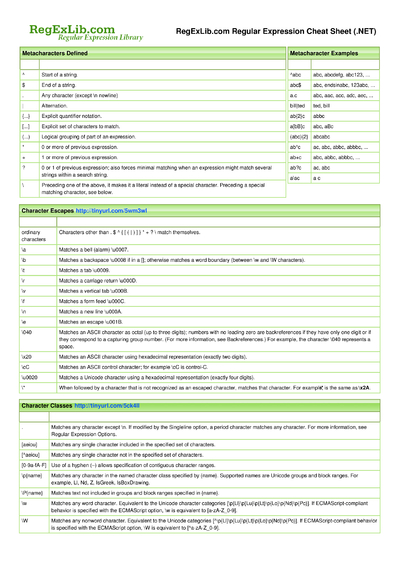
It is what the above two expressions will literally match. That said: The "match string" is the final product of either of the two above expressions. The image isn't meant to be explanatory, it is meant to be reference and refreshing material. Where it refers to python strings, and "regex strings" (which are actually Python "raw" strings) and something called "match strings". However, one part of the image is confusing.
#Python regex cheat sheet code
Exactement huit chiffres héxa doivent être fournis, même si le code point unicode le plus grand est \U0010ffff.


The re.LOCALE is not compatible with the re.ASCII flag. It makes the \w, \W, \b, \B and case-sensitive matching dependent on the current locale. The re.LOCALE is relevant only to the byte pattern. It means that the will also match lowercase letters. The re.DEBUG shows the debug information of compiled pattern.
#Python regex cheat sheet full
It makes the \w, \W, \b, \B, \d, \D, and \S perform ASCII-only matching instead of full Unicode matching. The re.ASCII is relevant to the byte patterns only.

Split a string at the occurrences of matches Return a string with matched replaced with a replacement Return the match at the beginning of a string or None Return a Match object if the whole string matches a pattern Return an iterator yielding all non-overlapping matches The following table shows the regex function from the re module. Match X but only if it is NOT followed by Y Reference the capturing group #N (alternative syntax) Match any single element except X, Y, and Z

Match its preceding element from n to m times Match its preceding element at least n times. Match its preceding element exactly n times. Match its preceding element zero or one time. Match its preceding element one or more times. Match its preceding element zero or more times. Match a position that is not a word boundary Match a position defined as a word boundary Match a single character except for a whitespace character Match a character except for a word character Match whitespace including \t, \n, and \r and space character Match a single word character a-z, A-Z, 0-9, and underscore (_) This page provides a Python regex cheat sheet that you can quickly reference while working with regular expressions.


 0 kommentar(er)
0 kommentar(er)
